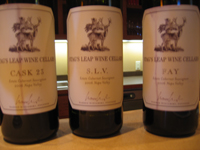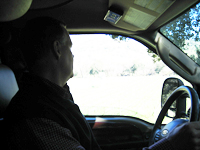 ‘Sustainable farming may be a recent phenomenon in the valley, but has not been so at Stag’s Leap Wine Cellars,’ says Kirk Grace, their renowned vineyard manager. “Ever since Warren Winiarski founded the winery in 1970 he maintained that environmental friendly wine growing practices influences the quality of wine.” Grace’s expertise in sustainable winegrowing caught Winiarski’s eye, and he was brought aboard to manage Stag Leap’s 225 acre estate in 2006. With his expertise in farming and leadership acumen in various sustainable farming practices including agricultural conservation, Grace was undoubtedly the best man for the job. ‘Sustainable farming may be a recent phenomenon in the valley, but has not been so at Stag’s Leap Wine Cellars,’ says Kirk Grace, their renowned vineyard manager. “Ever since Warren Winiarski founded the winery in 1970 he maintained that environmental friendly wine growing practices influences the quality of wine.” Grace’s expertise in sustainable winegrowing caught Winiarski’s eye, and he was brought aboard to manage Stag Leap’s 225 acre estate in 2006. With his expertise in farming and leadership acumen in various sustainable farming practices including agricultural conservation, Grace was undoubtedly the best man for the job.
Kirk Grace
In Napa Valley’s wine circles, Kirk Grace needs no introduction. Raised in Napa Valley, he has a B.S. in Crop Science followed by years of successful experience in managing various vineyards, including his own – the prestigious Grace Family Vineyards. He has been recognized for his various innovative approaches towards sustainable farming, the most notable among them being the 2004 Integrated Pest Management Innovator award from the California Department of Pesticide Regulation.
The Estate
.JPG) With an estate that offers a unique terroir, along with its proximity to the San Pablo Bay, Stag’s Leap vineyards are a mix of the best soil and climate that Napa Valley has to offer, comparable to Bordeaux’s unique elements. While the northern vineyard, FAY, is more alluvial in makeup, the southern vineyard, SLV’s soils are more volcanic in nature. Both these estates are divided by a water body, Chase Creek, and produce distinctly unique wines. The premium CASK 23 estate wine is made from the best fruit of both estates, only in great vintages, after careful inspection of each vine. With an estate that offers a unique terroir, along with its proximity to the San Pablo Bay, Stag’s Leap vineyards are a mix of the best soil and climate that Napa Valley has to offer, comparable to Bordeaux’s unique elements. While the northern vineyard, FAY, is more alluvial in makeup, the southern vineyard, SLV’s soils are more volcanic in nature. Both these estates are divided by a water body, Chase Creek, and produce distinctly unique wines. The premium CASK 23 estate wine is made from the best fruit of both estates, only in great vintages, after careful inspection of each vine.
While driving me through the estate, Grace pointed out that while most of the estate has been replanted, a certain section has vines which are more than 40 years old. “We try to preserve our vines as long as we can. If you’re doing it right, you get better experience of the land you’re farming on and produce better quality,” he explained.
Sustainability and Stag’s Leap Wine Cellars
Almost all of the grapes on the estate are grown organically. As Grace explains, “We don’t use insecticides or pesticides.” So how does he manage pests, especially with the recent scare of the European Grape Moth? “I use a variety of Integrated Pest Management (IPM) techniques such as cover crops, to minimize damage from pests. These crops planted between vine rows attract certain insects who feed on the bugs that are harmful to the grapevines.”
Grace went on to explain that each vineyard block has different requirements and therefore cover crops are matched accordingly. He also pointed out that the phenomenon of covers crops originated in vineyards, and proved to be so successful that the concept was adopted by other farming industries.
Water Conservation
Kirk Grace lays an extra emphasis on water conservation by employing drip irrigation as opposed to overhead water systems. “This enables us to deliver water directly to the root and monitor our water application,” he explains. He goes on to add that their main water supply is treated waste water from the nearby town of Yountville, carried through pipelines to Stag Leap’s reservoirs. “The town of Yountville doesn’t have to release their waste water in the Napa River. It’s beneficial to everyone.”
Wind Frost Machines
As we drive further, Grace directs my attention to various wind frost machines located strategically across the vineyards. Grace explained, “When I joined as Vineyard Manager, I did away with the smudge pots that were being used all along. The wind machines collect cold air and shoot it up, allowing the warm air to settle in the vines. Our newer machines work on 15HP motors and are fuel efficient.” These are a cut above the traditional smudge spots, which burn propane during severe frost bouts and are still employed by many vineyards.
Canopy Management
As part of sustainable farming, canopy management is intensively employed during the growing season. Frequent passes are made through the vineyard during which shoots are suckered and lateral shoots are removed to moderate the amount of air and light around the grapevine. This process naturally minimizes fungus and unwanted molds. When asked why such attention to detail, Grace justifies, “I believe in a self-sustaining system. If we can steer our vines towards the right fruit quality, we produce the highest quality grapes and everyone wins!”
Grace lays an extra emphasis on work-life balance for all his workers on the vineyards. When he took over as Vineyard Manager in 2006, the field workers worked six-day weeks, a common work week schedule in the wine industry. He wasted no time in reducing it to five and a half days. Grace believes, “Sustainability goes beyond the environment. It is also about people. With a proper work-life balance, people are more productive.”
.JPG) As Grace went on to explain some more unique aspects of other sustainability methods employed at Stag’s Leap Wine Cellars, such as the restoration of Chase Creek and preservation of the natural habitat, he stopped the truck in front of what appeared to be a serene yet scenic lake, which was actually a fire-fighting pond! One would wonder why so much landscaping effort into a fire-fighting pond. As Grace says, “All wineries have some form of fire-fighting techniques but to do it in a picturesque way is unique!” One has to see it to appreciate that it truly is, and only at Stag’s Leap Wine Cellars. As Grace went on to explain some more unique aspects of other sustainability methods employed at Stag’s Leap Wine Cellars, such as the restoration of Chase Creek and preservation of the natural habitat, he stopped the truck in front of what appeared to be a serene yet scenic lake, which was actually a fire-fighting pond! One would wonder why so much landscaping effort into a fire-fighting pond. As Grace says, “All wineries have some form of fire-fighting techniques but to do it in a picturesque way is unique!” One has to see it to appreciate that it truly is, and only at Stag’s Leap Wine Cellars.
The Hands of Time
.JPG) In 2007, Stag’s Leap Wine Cellars changed hands from founder and owner Warren Winiarski to a joint venture by Chateau Ste. Michelle of Woodinville, Washington and Marchesi Antinori Srl of Italy. However, Winiarski has etched a huge part of the winery’s history in the most unique way – Hands of Time. In 2007, Stag’s Leap Wine Cellars changed hands from founder and owner Warren Winiarski to a joint venture by Chateau Ste. Michelle of Woodinville, Washington and Marchesi Antinori Srl of Italy. However, Winiarski has etched a huge part of the winery’s history in the most unique way – Hands of Time.
While walking back to the winery, Grace took me to this landmark etched on the outer wall of one of the buildings. Grace explained that in 2003, Winiarski invited winemakers and viticulturalists who had been associated with Stag’s Leap in the past, or their closest next of kin, and had them imprint their hand on the wall. The wall includes hand imprints of wine greats such as Bob Sessions of Hanzell Vineyards, John Williams of Frog's Leap, Richard Ward of Saintsbury, Ricardo Herrera of Screaming Eagle, Paul Hobbs of Paul Hobbs Winery, Michael Silacci of Opus One, and John Kongsgaard of Kongsgaard Wine and Arietta, among others.
The Tasting Room
The 1976 ‘Judgment of Paris’ tasting was a defining moment for Californian Wines, when Stag Leap Wine Cellars’ 1973 S.L.V. Cabernet Sauvignon won the blind tasting, besting four renowned wines of Bordeaux. Since then the winery’s estate wines CASK 23, S.L.V. and FAY are considered among the premium Cabernet Sauvignons in the world.
We were met with the hospitality of Tasting Room Manager Adrian Rincon for an exclusive tasting graciously organized by Grace. Rincon had arranged for a tasting of all Stag’s Leap’s premium wines – 2006 ARTEMIS Cabernet Sauvignon, 2006 Merlot, 2007 KARIA Chardonnay, 2007 Sauvignon Blanc, and the Estate Wines. I chose to taste only three of the four Estate Wines (excluding the 2007 ARCADIA Chardonnay) – 2006 CASK 23 Cabernet Sauvignon, 2006 S.L.V. Cabernet Sauvignon, and 2007 FAY Cabernet Sauvignon – to complete my ‘journey of taste’ that started in the vineyard and to see for myself why these wines were considered amongst the world’s finest.
As I proceeded with the tasting, I found all three wines to be distinct in their levels of tannin (with the same alcohol content at 14.5%), and as Rincon rightly said, “specific to a certain place.” While the SLV was more delicate, and the FAY more perfumed with wet fruit flavors, I found the CASK 23 to be velvety and tannic with more of a European flavor. Of course, our tasting notes differed which is true to the nature of wine – which provides a different experience to different palates. Every year, the estate produces only 8,000 cases combined of its estate wines which are sold direct to consumers. At the end of it all, Stag’s Leap Wine Cellars’ fine estate wines are well worth the premium price.
 One encounters people with various talents that they use in a unique way. But rarely does one come across a person like Kirk Grace, a man with one unique talent who uses it in many unique ways, and is, above all, literally “down to earth.” Our journey of taste truly exemplified his strong belief that environmental and social stewardship can translate into a fine quality product. One encounters people with various talents that they use in a unique way. But rarely does one come across a person like Kirk Grace, a man with one unique talent who uses it in many unique ways, and is, above all, literally “down to earth.” Our journey of taste truly exemplified his strong belief that environmental and social stewardship can translate into a fine quality product.
 Rishi Vohra, our California Correspondent, is a filmmaker and writer who occasionally contributes articles to the Times of India and The Hindu, besides being the California correspondent for delWine. He has recently completed an MBA degree in Sustainable Business from San Francisco State University and Masters Diploma in Environmental Law from WWF-India. Vohra lives in Berkeley and often visits Napa and Sonoma Valley wineries. He may be contacted at rishi7777@gmail.com Rishi Vohra, our California Correspondent, is a filmmaker and writer who occasionally contributes articles to the Times of India and The Hindu, besides being the California correspondent for delWine. He has recently completed an MBA degree in Sustainable Business from San Francisco State University and Masters Diploma in Environmental Law from WWF-India. Vohra lives in Berkeley and often visits Napa and Sonoma Valley wineries. He may be contacted at rishi7777@gmail.com
|